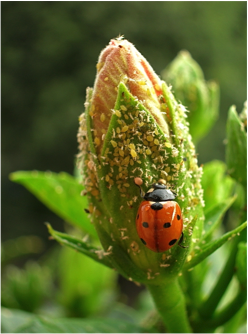Team:KU Leuven/Project/Ecological/wetlab
From 2013.igem.org
| Line 22: | Line 22: | ||
<div class="row-fluid"> | <div class="row-fluid"> | ||
<div class="span6"> | <div class="span6"> | ||
| - | <p align = "justify"> | + | <p align = "justify">In order to validate the <b>BanAphids'</b> model, we decided to investigate the effect of the two substances, E-beta-farnesene (EBF) and Methyl Salicylate (MeS) on aphids. Once we started our project, we noticed that we were not the only ones approaching this agricultural problem from this angle. Research groups like Rothamsted are currently investigating the use of EBF to repel aphids as well but in the form of GM crops. We also found that other areas of the industry were also interested in our project such as Biobest, worldwide leader in sustainable crop protection and pcfruit whose mission is to research prospects for biological fruit growing, new crop protection methods, etc. We were invited to perform our insect experiments at Biobest and pcfruit to validate the <b>BanAphids</b> model. We attempted to determine the working concentrations of our two substances in pure form and to examine the preference of aphids and their predators under different conditions and environments. With the data we have collected so far, we can observe that these two substances indeed do have an effect on aphids. |
| + | </p> | ||
</div> | </div> | ||
Revision as of 18:19, 2 October 2013
Secret garden
Congratulations! You've found our secret garden! Follow the instructions below and win a great prize at the World jamboree!
- A video shows that two of our team members are having great fun at our favourite company. Do you know the name of the second member that appears in the video?
- For one of our models we had to do very extensive computations. To prevent our own computers from overheating and to keep the temperature in our iGEM room at a normal level, we used a supercomputer. Which centre maintains this supercomputer? (Dutch abbreviation)
- We organised a symposium with a debate, some seminars and 2 iGEM project presentations. An iGEM team came all the way from the Netherlands to present their project. What is the name of their city?
Now put all of these in this URL:https://2013.igem.org/Team:KU_Leuven/(firstname)(abbreviation)(city), (loose the brackets and put everything in lowercase) and follow the very last instruction to get your special jamboree prize!


E. coligy: Plants with BanAphids - insect experiments
In order to validate the BanAphids' model, we decided to investigate the effect of the two substances, E-beta-farnesene (EBF) and Methyl Salicylate (MeS) on aphids. Once we started our project, we noticed that we were not the only ones approaching this agricultural problem from this angle. Research groups like Rothamsted are currently investigating the use of EBF to repel aphids as well but in the form of GM crops. We also found that other areas of the industry were also interested in our project such as Biobest, worldwide leader in sustainable crop protection and pcfruit whose mission is to research prospects for biological fruit growing, new crop protection methods, etc. We were invited to perform our insect experiments at Biobest and pcfruit to validate the BanAphids model. We attempted to determine the working concentrations of our two substances in pure form and to examine the preference of aphids and their predators under different conditions and environments. With the data we have collected so far, we can observe that these two substances indeed do have an effect on aphids.

Aphid infested Rose plant (Mauro Mandrioli)
 "
"



